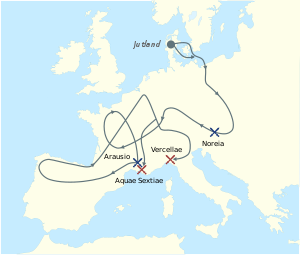Cimbrian War
| Cimbrian War | |||||||
|---|---|---|---|---|---|---|---|
 The migrations of the Cimbri and the Teutones. |
|||||||
|
|||||||
| Belligerents | |||||||
| Roman Republic |
Cimbri Teutones Ambrones Tigurini |
||||||
| Commanders and leaders | |||||||
|
Gaius Marius Quintus Lutatius Catulus Quintus Servilius Caepio Gnaeus Mallius Maximus Gnaeus Papirius Carbo Lucius Cassius Longinus † Lucius Calpurnius Piso † Marcus Junius Silanus |
Boiorix † (Cimbri) Lugius † (Cimbri) Claodicus (POW) (Cimbri) Caesorix (POW) (Cimbri) Divico (Tigurini) Teutobod (POW) (Teutons) |
||||||
| Strength | |||||||
| Varied, ranging from around 40,000 to 150,000 | Varied but estimated at around 300,000–500,000 | ||||||
| Casualties and losses | |||||||
| 110,000–150,000 | 300,000–500,000, Both tribes annihilated |
||||||
The Cimbrian or Cimbric War (113–101 BC) was fought between the Roman Republic and the Germanic tribes of the Cimbri and the Teutones, who migrated from the Jutland peninsula into Roman controlled territory, and clashed with Rome and her allies. The Cimbrian War was the first time since the Second Punic War that Italia and Rome itself had been seriously threatened.
The timing of the war had a great effect on the internal politics of Rome, and the organization of its military. The war contributed greatly to the political career of Gaius Marius, whose consulships and political conflicts challenged many of the Roman republic's political institutions and customs of the time. The Cimbrian threat, along with the Jugurthine War, inspired the landmark Marian reforms of the Roman legions.
Rome was finally victorious, and its Germanic adversaries — who had inflicted on the Roman armies the heaviest losses that they had suffered since the Second Punic War with victories at the battles of Arausio and Noreia — were left almost completely annihilated after Roman victories at Aquae Sextiae and Vercellae. Some of the surviving captives are reported to have been among the rebelling Gladiators in the Third Servile War.
For reasons unknown (possibly due to climate change, see Pre-Roman Iron Age), sometime around 120–115 BC, the Cimbri left their original lands around the Baltic sea in the Jutland peninsula and Southern Scandinavia. They journeyed to the southeast and were soon joined by their neighbors and possible relatives the Teutones. Together they defeated the Scordisci, along with the Boii, many of whom apparently joined them. In 113 BC they arrived on the Danube, in Noricum, home to the Roman-allied Taurisci. Unable to hold back these new, powerful invaders on their own, the Taurisci called on Rome for aid.
...
Wikipedia
